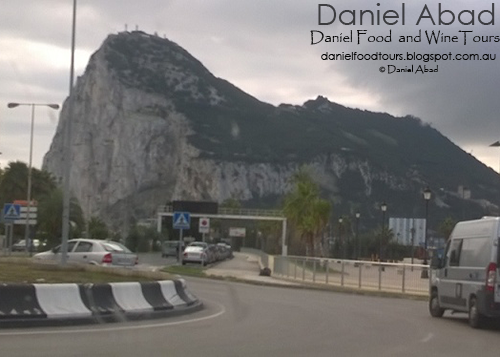We left Malaga in the morning and headed for Gibraltar. Three main reasons for wanting to visit that famous place. Firstly; to get to the top of the rock and watch the African continent from Europe. The weather unfortunately decided otherwise. It was a cloudy and foggy day when we arrived, making it impossible to see anything.
 |
| Going up the Rock |
 |
| Gibraltar and the Harbour - view from the Top of the Rock
We still went up for the second reason: to see the apes who live there. Most of the Rock's upper area is covered by a nature reserve which is home to around 250 or so Barbary Macaques; the famous apes of Gibraltar. These are the only wild monkeys found in Europe. This species is listed as endangered and is declining. They were all there in force and waiting to grab anything from the plastic bags that any unsuspecting tourist might be carrying.
|
 |
| Babies Playing |
 |
| Posing for the Camera |
 |
| Mum and Child |
 |
| Dad Supervising |
Lastly and for sentimental reasons, I wanted to see where John Lennon and Yoko Ono were married. I have always been a John Lennon fan and I simply couldn’t miss being so close and not visiting the place where they tied the knot.
When you first see the Rock of Gibraltar
from the road, this 426-metre-high peak of limestone is an
impressive stature, towering above the surrounding countryside. The Rock signals the position of the Strait
of Gibraltar, which separates Europe from Africa and provides the only link
between the Atlantic Ocean and the Mediterranean Sea.
British Overseas Territory located on the southern end of the Iberian Peninsula Gibraltar covers an area of 6.7km2. It shares its northern border with the Province of Cádiz in Andalusia, Spain. At its foot lives a population of over 30,000 Gibraltarians and other nationalities.
An Anglo-Dutch force
captured Gibraltar from Spain in 1704 during the War of the Spanish Succession. The territory was subsequently
ceded to Britain "in perpetuity" under the Treaty of
Utrecht in 1713. During World War Two it was an enormously
important base for the Royal Navy as it controlled
the entrance and exit to the Mediterranean
Sea, which is only eight miles wide at this
point. Today Gibraltar's economy is
based largely on tourism, financial services, and shipping.
The sovereignty of
Gibraltar is a major point of contention in Anglo-Spanish relations as Spain asserts a claim to the territory. Gibraltar governs its own
affairs, though some powers, such as Defence and Foreign Relations, remain the
responsibility of the Government of the United Kingdom. On the Rock of Gibraltar, the past is a
living reality. A colourful ceremonial
event such as the Changing of the Guard is performed exactly as they have been
for centuries.
Gibraltar’s history begins at the Stone
Age. Evidence of Neanderthal habitation in
Gibraltar between 28,000 and 24,000 BC was confirmed when the first
Neanderthal skull ever was discovered in 1848.
This discovery made Gibraltar the last
known holdout of the Neanderthals. Among
the first inhabitants, were the Phoenicians, around 950 BC. The Carthaginians and Romans also established
semi-permanent settlements there. After
the collapse of the Roman Empire, Gibraltar came
briefly under the control of the Vandals until the Islamic conquest of Iberia in 711 AD.
Since falling into British control, the Rock became a key base for the British Royal
Navy. It has played a major
role in some of the most famous episodes of History. The body of Nelson,
preserved in a barrel of rum, was brought to Gibraltar after his magnificent
victory at Trafalgar.In the 1950s, Franco renewed Spain's claim to sovereignty over Gibraltar and restricted movement between Gibraltar and Spain. Spain completely closed the border with Gibraltar and severed all communication links. The border with Spain reopened in 1985 prior to Spain's accession to the European Community.
One notices a rapid
change of lifestyle once in Gibraltar. Within
a few hundred metres, you leave lively and noisy Spain and are dropped straight
into a much quieter and very reserved British environment. Unlike its Spanish neighbours who go out
until all hours of the night, I was quite surprised when we went out for a meal
around 9.00 PM and found practically everything shut and hardly anyone in the
streets. We finally found a general store
and purchased a few items to take back to the hotel. My idea of a nice dinner in a restaurant became
a few snacks evening in front of the television
 |
| Gibraltar Bobby |
 |
| Traditional English Letter Box |
 |
| Gibraltar Crystal |
 |
| Some of the Pieces on Display |
 |
| Gibraltar Crystal Vases |










No comments:
Post a Comment